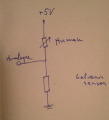| (2 intermediate revisions by the same user not shown) | |||
| Line 15: | Line 15: | ||
This work questions the feelings of organisms such as Physarum Polycephalum and how it perceives stimulation or even pleasure. Although it is stimulating itself, it does not know it does so and did not even give consent. It is a very speculative and philosophical perspective on the world of organisms that have no brain or what we describe as consciousness. | This work questions the feelings of organisms such as Physarum Polycephalum and how it perceives stimulation or even pleasure. Although it is stimulating itself, it does not know it does so and did not even give consent. It is a very speculative and philosophical perspective on the world of organisms that have no brain or what we describe as consciousness. | ||
===Friedrich Wilhelm Pittelkow, A social network for microorganisms=== | |||
https://www.uni-weimar.de/kunst-und-gestaltung/wiki/GMU:Different_Worlds/Friedrich_Wilhelm_Pittelkow | |||
"We use technology to connect each other. In the last years social media platforms emerged and gained popularity. Is the use of technology limited to humans or is it possible to develop and apply such a network to different worlds. Can technology be used to "talk" or interact with microorganisms and me or humans?" (Friedrich Wilhelm Pittelkow) | |||
===Carlos Garcia Fernandez, DJglove=== | |||
https://www.uni-weimar.de/kunst-und-gestaltung/wiki/GMU:My_Computer,_Max,_and_I/Carlos_Garcia_Fernandez | |||
"DJglove is a device than can be used to control different parameters that will modify a sound track through different filters and echo effects. The idea is to control all the different options just by touching the different metallic stripes that cover the glove, applying a particular effect with every different touch." (Carlos Garcia Fernandez) | |||
==Other artworks== | ==Other artworks== | ||
Latest revision as of 11:39, 14 April 2022
- introduction to tools at the DIY Biolab
Sensor
the most simple self-made sensor
Student works
Nicolas Krewer, Self Pleasure
https://www.uni-weimar.de/kunst-und-gestaltung/wiki/GMU:Being_a_Unicellular_Organism/Nicolas_Krewer
This work questions the feelings of organisms such as Physarum Polycephalum and how it perceives stimulation or even pleasure. Although it is stimulating itself, it does not know it does so and did not even give consent. It is a very speculative and philosophical perspective on the world of organisms that have no brain or what we describe as consciousness.
Friedrich Wilhelm Pittelkow, A social network for microorganisms
https://www.uni-weimar.de/kunst-und-gestaltung/wiki/GMU:Different_Worlds/Friedrich_Wilhelm_Pittelkow
"We use technology to connect each other. In the last years social media platforms emerged and gained popularity. Is the use of technology limited to humans or is it possible to develop and apply such a network to different worlds. Can technology be used to "talk" or interact with microorganisms and me or humans?" (Friedrich Wilhelm Pittelkow)
Carlos Garcia Fernandez, DJglove
"DJglove is a device than can be used to control different parameters that will modify a sound track through different filters and echo effects. The idea is to control all the different options just by touching the different metallic stripes that cover the glove, applying a particular effect with every different touch." (Carlos Garcia Fernandez)
Other artworks
Miya Masaoka, Pieces for Plants
http://www.youtube.com/watch?v=1AHOEcAprc8
Masaoka uses electronic interfaces attached to the plants to generate sound (as well as text, appearing in a video performance). While changing her body position in relation to the plants (approaching, touching, retreating), Masaoka changes the physical properties of the space, which, in turn, affects the plants. Plants sense the changing environment and further transport the captured changes in the form of electrical signals to the electrodes attached to them. The electrical signals captured are then translated into digital signals and transferred into the computer for further manipulation.
Martin Howse, Radio Mycelium
http://libarynth.org/parn/radio_mycelium
Howse examines connectivity and interaction between the physical properties of the environment and mycelium networks from a scientific, cultural and technical perspectives. "The Radio Mycelium workshop aims to actively examine the cross-spore-germination between two parallel wide area networks; between radio-based communication technologies and the single organism network of the mycelium." (Martin Howse)
Laura Popplow, Fungutopia
As a very complex project, Fungutopia becomes a platform to discuss a variety of topics related to fungi. Along with the reference topics covered by Paul Stamets, Fungutopia is also about cooking, DIY electronics, open-source initiatives, sustainability, social practices and, of course, contemporary aesthetics.
Mindaugas Gapševičius, You and I, You and Me
http://triple-double-u.com/you-and-i-you-and-me/
The project You and I, You and Me explores the possibilities of communication through electricity. The project proposes that electricity could help to reveal the imperceptible connections between different actors within the environment. How far could electricity help in understanding the other? Is there a possibility to alter human senses by electric impulses?



